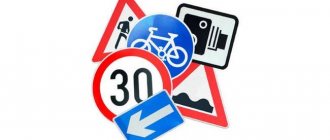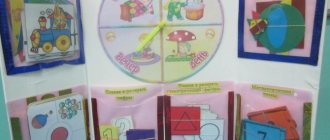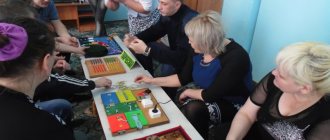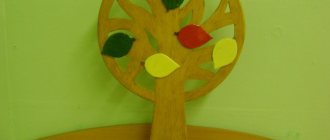Definition
Mnemonics (mnemonics) is a list of methods and techniques that help remember various types of information.
Mnemonics is based on the principle of visualizing abstract objects, which are replaced by specific concepts or figurative definitions. To easily and quickly memorize the necessary information, you need to associatively associate it with some visual idea, sound image or sensation. Associations - establishing connections with known images and phenomena.
Mnemonics for children
Over the past few decades, this innovative direction in pedagogy and speech therapy has become popular. Kindergarten teachers began to pay more attention and time to speech development.
Classes are held in groups where children get acquainted with works of art, poetry, and fairy tales. It is especially useful to memorize poems and read them with expression. This trains memory, shapes speech, and enriches vocabulary.
Expressiveness of performance develops speech technique - diction, breathing. To do this, special exercises are carried out to help develop speech hearing and clear pronunciation of sounds and words. Also, the educational program of the preschool educational institution includes classes on mnemonics.
How does memory work in preschool children?
Before moving on to a description of the principle of using mnemonic tables, it is necessary to dwell on the features of memory development in preschoolers. First of all, it is important to say that in the majority of preschool children, figurative memory predominates (this can be visual, as well as auditory, olfactory and other images of perception). At the same time, children remember information mainly mechanically, involuntarily. That is, the child remembers what interests him or what makes a strong impression on him. Therefore, an unusual and bright form of presentation is very important. With the development of speech, children's ability to perceive words increases: a preschooler can memorize poetry, he easily remembers the plots of fairy tales and cartoons. However, according to psychological and pedagogical research, it is much easier for children to reproduce information if in the process they can rely on visual diagrams. In older preschool age, the child begins to form voluntary memory. With the development of the ability to self-control, the baby learns to independently remember information that may be useful to him. It is visual aids (diagrams, sketches, notes) that allow children to better remember the necessary material.
Preschool children have the most developed figurative memory, therefore, in order for the child to better remember any information, it is necessary to use various visual aids, including mnemonic tables.
Mnemonic techniques
- Eidotehnika (eido - image) - representation of an object outside the zone of perception, i.e. application of imaginative thinking. The exercise is aimed at creating images, objects, and natural phenomena.
- Associative chain technique . Words are connected in order, one after another, without skipping. The result is a story or fairy tale. In this game, children quickly remember a chain of words.
- The Cicero method is the placement of information in space. The essence of the method is the imaginary placement of images in a specific place.
- Method of transformation (transformation). Exercise promotes the development of memory and logical thinking. The words seem to flow from one another, something unites them.
- Support method (numeric-letter method). Children remember information by associating the meaning of certain words, sounds and numbers.
- “Croqueting” technique (from the French word croquis - drawing, sketch). Method of graphic associations. The essence is to recode the information received when drawing objects and natural phenomena.
Mnemonic table, mnemonic square, mnemonic track, collage - these are the teaching tools of the crocheting method.
Mnemonic tables are images containing information. They reduce learning time and at the same time develop memory, attention, and creative thinking. Help transform abstract images into concrete objects.
A mnemonic square is a card with an image of encoded information.
Mnemonic track is a sequential distribution of mnemonic squares according to which the child composes a story.
Collages are aids that perform the following tasks:
- teach (thematic collages);
- remember;
- form the skill of attention distribution.
Methodological manual on the lexical topic “Professions”. Mnemotables.
Shabalina S.V.
teacher speech therapist
MBDOU kindergarten No. 139
Irkutsk.
Didactic manual: Mnemotables on the lexical topic “Professions”.
Target:
To create conditions for the development of coherent speech of children with severe speech disorders in a speech therapy group.
Tasks:
1. Motivate children to introduce speech activity using mnemonic techniques.
2. Promote the development of memory, attention, thinking, curiosity, and interest in mnemonic tables.
4. Create a desire to help each other in storytelling using mnemonic tables.
Age group: 5-7 years.
Pedagogy has long been looking for ways to achieve high-quality results in working with children. Reacting to innovative changes in conditions and requirements in society, pedagogy creates more and more new approaches to education. When choosing pedagogical concepts, teachers first of all pay attention to their effectiveness. Teachers seeking to improve the quality of teaching and education are increasingly using pedagogical technologies in the educational process. The word “technology” comes from the Greek words: “techne” - art, skill, skill and “logos” - science, law. Literally, “technology” is the science of craftsmanship. Mnemonics (from the Greek mnemonikon - the art of memorization) is a system of special techniques that serve to facilitate the memorization, preservation and reproduction of information. The purpose of teaching mnemonics is the development of memory, thinking, imagination, attention, namely mental processes, because they are closely related to the full development of speech. Mastering the techniques of working with mnemonic diagrams significantly reduces training time and at the same time solves problems aimed at: developing basic mental processes - memory, attention, imaginative thinking and speech; recoding of information, i.e. transformations from abstract symbols to images;
In my correctional and developmental work with children with severe speech impairments, I constantly use mnemonic tables to correct sound pronunciation, to develop coherent speech, and to memorize poems. Using mnemonic tables, you can retell and compose stories and fairy tales. I present to your attention mnemonic tables on the lexical topic “Professions”, which were made with my own hands.
Driver-
Previously, people rode horses harnessed to sleighs and carriages. Now people travel by passenger transport. Freight transport transports various goods. The driver must know the traffic rules by heart and never break them. Many drivers work on public transport - trams, buses, trolleybuses. A driver who works as a taxi driver takes people around the city. He knows all the city streets and alleys well. Vehicles are filled with gasoline at a gas station.
Lifeguard - male
profession. If an earthquake, flood, or disaster occurs, they call: 112 and call for rescuers to help. Rescuers have special tools that they use in rescue operations. Rescuers fly in and rescue people by helicopter. To remove a person from a height, rescuers arrive in emergency vehicles. Trained dogs help search for people under the rubble. Rescuers save children and adults. For saving people, rescuers are awarded medals and orders.
Fireman-Fire
can happen due to a child playing with matches, due to faulty electrical wiring, due to an unextinguished cigarette, due to a forgotten turned off iron. If there is fire or smoke, you need to immediately call: 01. Firefighters arrive in a fire truck to extinguish the fire. They are bright red with a folding ladder on the roof. As they rush through the streets, all the cars give way to them, hearing the loud sound of a fire siren. Firefighters wear a steel helmet on their heads, pants and jackets are made of thick tarpaulin, and durable rubber boots are on their feet. The fire is doused with water from special hoses. They are called "Sleeves". Water is pumped into the hoses by a pump, which firefighters bring in a fire truck. The fire is extinguished with special foam contained in fire extinguishers. Firefighters fearlessly make their way into burning buildings and save people. A tall folding ladder also helps firefighters, using which they get inside a burning house through windows and balconies. For these feats, firefighters are awarded medals and orders.
The builder is
a man who works at a construction site. He builds houses. Lays high walls out of bricks. He has construction tools for his work. For his safety, the builder wears a helmet on his head. Dressed in special construction clothing. A builder lifts bricks up using a crane. Previously, when there were no cranes, the builder used a stretcher and a cart to transport bricks for work. To build a house, they first dig a pit with a bulldozer. Then the foundation of the house is poured with concrete, and then the walls begin to be laid out from bricks. Previously, houses were built from wooden logs, but now tall multi-story buildings are being built. There are several apartments on each floor. When the house is built, new residents move in. They bring furniture, electrical appliances, things and start living in a new house.
Diver-
this is a person who goes underwater in special spacesuits. The diver breathes with air that comes from cylinders through a special tube. The diver carries his own supply of air with him, attached to his back. Underwater, a diver watches fish and jellyfish through a mask. He sees dolphins swimming. Divers perform various types of work underwater: repairing the bottoms of ships, exploring the bottom, searching for and lifting sunken ships and cars, and conducting rescue operations. Divers rescue people and ships that have been wrecked. Divers are strong, brave and trained people.
Sailor-
is a person who serves on a Navy ship. The captain is the most important person on the ship. The entire crew of sailors listens to him. The captain controls the ship, plots the route along which the ship sails. He knows everything about waves and storms. He knows many different sciences: astronomy, geography, mechanics and maritime affairs. Sailors wear a cap without a visor and a vest - a striped shirt. The captain has a captain's cap on his head and wears a captain's uniform.
Previously, people sailed on water in wooden boats. Now they sail on ships, yachts, and boats. The captain always stands on the bridge and looks through the telescope. He determines the direction using a compass. The sailor stands at the helm and looks forward. If a person is spotted floating in the water, a lifebuoy is thrown to him. When the ship reaches the shore, the anchor is lowered into the water. There are often storms and high waves in the sea and ocean; in such weather, a ship can crash on the rocks. And then a shipwreck occurs. On a clear day, the sea and ocean are calm and you can see many different ships. At night, in order not to go astray, sailors are helped by a lighthouse glowing with bright light. Russian ships sail to different countries and meet amazing islands along the way.
Educator-
This is a person who raises and teaches children in kindergarten. In kindergarten, children play with toys. The teacher reads interesting books and fairy tales to the children. If one of the children offends someone, the teacher lovingly takes pity and calms the child down. During classes, children draw with pencils, make crafts from colored paper, have lunch and sleep in cozy beds. Together with the teacher they walk on the playground. The teacher works in a state kindergarten.
Doctor-
The most important profession. The doctor treats sick people and children. The doctor is always dressed in a white coat and has a phonendoscope hanging around his neck. The doctor measures the temperature with a thermometer. He writes prescriptions for which people buy pills and medicines at the pharmacy. The doctor gives injections with a syringe. If a person injures the skin, the doctor uses cotton wool and a bandage. When a person gets sick. Then the doctor is called by phone: 03. The doctor arrives in a special ambulance. An ambulance takes the patient to the hospital. Surgeons work in the hospital. They perform operations in the operating room. A doctor who treats children is called a pediatrician.
Cook-
this is the person who prepares the food. The cook wears a white cap and apron, with a ladle in his hand. Electrical appliances help him prepare food: a mixer, a stove, a meat grinder. The cook stores the food in the refrigerator. To prepare food, the cook uses kitchen utensils and cutlery. When I go, the chef cooks according to the recipes in the cookbook. Before preparing food, the cook must wash his hands with soap, rinse them thoroughly with water and wipe them dry with a towel. The cook prepares porridge and salads, omelettes, fries fish, and cooks soups. A cook works in a cafe and restaurant, in the canteen. The cook also knows how to cook and bake cakes and cookies. In kindergarten, the cook prepares food and feeds the children tasty, healthy food with vitamins.
Teacher-
On September 1, schoolchildren go to school. The school bell rings, inviting students to class. Schoolchildren put school supplies in their briefcases: pencil case, pens, pencils, ruler, textbooks, notebooks. At school, students write and study in lessons taught by a teacher. The teacher reads interesting books and tells interesting material. During lessons, the teacher introduces the children to the globe, writes on the board with chalk and shows what is written on the board with a pointer. Schoolchildren do homework: learn poetry, read textbooks. Tell the teacher about what new and interesting things they learned in class.
Pilot-
This is a person who knows how to fly an airplane and a helicopter. In ancient times, people admired the flight of birds. They loved how easily they floated in the air. People began to invent flying machines: balloons, airships. Then airplanes and helicopters appeared. People have learned to land on the ground using a parachute. A pilot flies high into the sky on an airplane and helicopter. He flies over the earth and sees forests, rivers, lakes, seas and mountains from above.
Carpenter (joiner)
) The furniture is made by a carpenter. Woodworking has its own special tools: plane, chisel, chisel, saw, axe, hammer, drill. A carpenter is engaged in wood processing, construction and repair of wooden houses. A carpenter makes and installs wooden window frames, doors, and fences. He makes wooden shelves, bookcases, cabinets, chairs, sofas. Old furniture needs to be taken care of and repaired so that it lasts for many years.
Hairdresser-
This is a person who cuts long hair, does hair styling and curling. To work, a hairdresser needs a mirror, scissors, a hair dryer, a comb, curlers, shampoos, paints, and balms. When styling hair, the hairdresser uses hairsprays, gels, and foams. First, the hairdresser sits the person in a comfortable chair, covers his shoulders with a special cape, then thoroughly rinses his hair with shampoo. Then lightly dries the hair with a towel. Then he picks up a comb and scissors and begins to cut the hair strand by strand, giving it a certain shape. A hairdresser works in a hairdressing salon or beauty salon. When the haircut is ready, the hairdresser can blow-dry, curl the hair and apply hairspray.
Astronauts-
these are strong, brave people. Cosmonauts wear special protective clothing - a spacesuit. Artificial satellites revolve around the Earth, orbital space stations have been created where astronauts live and work. Cosmonauts study other planets, study the stars, the surface of our earth, check the weather, photograph the Earth. The title of the first cosmonaut on the planet belongs to Yuri Alekseevich Gagarin, who on April 12, 1961, made the first orbital flight in the history of mankind on the Vostok spacecraft. For their exploits, astronauts are awarded medals and orders.
Exercises for preschoolers
Preschool age is considered a favorable period for laying the foundations of competent, clear, beautiful speech. Mnemonics for beginners (simple, fun tasks, games) will help your child’s speech develop faster. It is useful for the development of the articulatory apparatus to perform tasks using onomatopoeic words. They correct diction well - pure jokes (“If only there was smoke coming out of the chimney”), nursery rhymes, phrases containing a certain group of sounds (“Sanya’s sleigh rides on its own”).
Exercises on the pronunciation of hissing sounds can be combined thematically.
After looking at the picture “Hedgehog and Hedgehogs,” the adult offers to complete a number of tasks. The child must clearly pronounce phrases with the sounds “sh” and “zh”. “Sha-sha-sha - we walk slowly; shu-shu-shu - I’ll give the baby a raspberry; shi-shi-shi - where the kids walk.” Such exercises help you master question intonation and develop a sense of rhythm.
By isolating the sound while clearly pronouncing a word, the skill of understanding the terminology “sound” and “word” is developed. When working with children, it is necessary to emphasize the development of intonation sense, rate of speech, diction, and strength of voice. Games can help with this.
Exercises for beginners:
- "Whose voice is this ? The goal of the game is for the child to learn to recognize adult animals from young animals by the reproduced sound. For such a game, you can take figurines of a dog and a puppy, a duck and a duckling, a cat and a kitten. Alternatively, you can sculpt animals from plasticine or use cards. The plot of the game: animals come to visit the baby, they want to play with him. Children should understand the difference between how a mother cat meows and how her baby meows.
- Game "Compare the cubes" . The task is to teach the child to correlate objects with different characteristics. An adult offers to look at two cubes and tell how they differ. The kid takes one cube and says that it is big, and the second cube is small. The first cube is red and the second is white. The red cube is plastic, the white cube is made of fabric and is soft inside.
- Game “Compare two kittens” . The child is asked to look at the kittens. One of them is white and large, and the second is black and smaller. You need to say who they are. Come up with names for them so that it is clear that one kitten is black and the other is white. What is the difference.
- Game “What little animals can do . The goal of the game is to choose verbs that denote the characteristic actions of animals. An adult shows pictures of animals, and the child must say what they can do or what they say. For example, a cat loves mice. She loves to meow. The dog loves to bark and eat bones, run and jump. The cockerel crows and loves to peck grains.
- Game "Profession" . Here you will need cards that depict people of different professions (pilot, hairdresser, doctor, cook). An adult asks who heals people. The kid must answer correctly. This is how the remaining cards are played.
- The game “Wizards” helps expand vocabulary, develops long-term memory and logical thinking. You will need cards with images of individual objects - a table, an apple, a door. The adult names several words, and the child must choose those cards that will help him remember the named words. He kind of “bewitches” them into these cards. Then the baby takes the cards and with their help remembers the named words. The game is aimed at understanding the logical connections between objects.
Regular playful activities help to awaken interest in words. The exercises prepare children for further independent compilation of narratives, stories, texts, and form connected speech.
How to create a mnemonic table yourself?
When working with your little one, you can use both ready-made mnemonic tables and ones you make yourself. In order to make a table based on a poem or story, you need:
- Divide the text into fragments (the younger the child, the shorter).
- Draw squares on a piece of paper according to the number of text fragments.
- In each square, depict what is said in the fragment, or what is associated with it. A child of senior preschool age can independently draw pictures for the table.
- If you wish, you can sign the text in each square that you need to remember.
Rules for conducting classes
The process of working and learning with children should be comfortable and beneficial.
- You need to start with simple tasks. First, you can look at cards with single images.
- You should not immediately overload your preschooler; he will quickly get tired and will not absorb the information. You can show no more than two mnemonic tables per day.
- All images of didactic material must be bright and colorful. Children quickly remember colorful images. The grass is green, the carrot is orange, the pine cone is brown, the sea is blue.
- It is worth changing the topic of the lesson every time, otherwise the child will lose interest. Today we are learning poetry. Tomorrow - a fairy tale, wild animals, etc.
- It is important that classes take place only in a playful way.
Visualization techniques
When memorizing poems, each line is depicted with pictures.
Mnemonics techniques are based on the use of certain types of memorization . Of course, the most effective way to use any technology for raising and developing a child is through play. And mnemonics in this sense are a real storehouse of ideas.
- "Get a group together." The child is given separate pictures (for example, symbols of the seasons, clothes, types of activities) - he needs to group the pictures and explain why they are together.
- “Draw your impressions.” This technique perfectly expands the baby's vocabulary. And, by the way, it forms family traditions. Invite your little one to sketch their impressions of the day together, so that later they can tell what was good and bad about it. Each time, try to add one or more concepts and words that are new to your child.
- "Learn a poem." To make it easier to memorize poems, use visual tables in which each line is presented in the form of a picture or symbol. Try to always supplement the image with a word (if the baby can read) or a letter (if the child has not yet mastered this skill).
- "Memory Grid". Show your child the pictures, say what they are and turn them over. The child’s task is to name the depicted object, and then test himself by opening the mnemonic picture.
- "Stories with pictures." On the Internet you can find a lot of children's stories in which words are partially replaced by pictures. This way, the baby not only learns new words, but also develops the ability to focus on reading.
- "Photo memory". Show the child a picture, then remove it and give in return another one that differs from the first in some detail. For example, the first one shows a girl with a red bow, and the second one shows the same girl, but the bow is blue.
- "Day Night". Place a series of pictures in front of your child. Then say, “Night has come.” The baby covers his eyes with his hands, and at this time you hide one picture. The child’s task is to guess what is missing.
There are several methods of working with children over one year old whose speech is just beginning to develop.
- Tactile games. This mnemonic technique is intended for the smallest toddlers who do not yet speak. Its essence lies in the fact that pictures are replaced with objects. For example, to get acquainted with different round objects, put a pebble of a suitable shape, a tennis ball, a cap from a bottle or tube of cream, etc. in a bag. Ask your baby to take this or that object out of the bag by touch.
- Sound lotto. Play sounds for your child to match the pictures to. For example, “Who talks like this”: listen to the meow of a cat, the roar of a lion and ask the child to show a picture of the animal.
- Flannelograph. Cover the magnetic board with fabric and purchase a set of pictures with magnets (you can make them yourself by gluing a magnet to the back of the image). Tell your baby stories, pausing at certain parts. The little one’s task is to choose a suitable picture depicting the object you settled on and attach it to the flannelgraph.
Rules for using mnemonic techniques
You both need to be in the right mood to work with your baby.
As you know, children quickly lose interest in one activity or another. But mnemonics requires regular practice. Therefore, try to adhere to the following rules so that your baby does not get bored:
- offer to play only when the child is not hungry and does not want to sleep;
- do not interrupt the little one if he is already busy with something - it is better to wait for a more convenient opportunity;
- make classes traditional, preferably at the same time;
- do not rush the child, give him time to comprehend the task;
- help find a solution if you see that your child has stalled or is going in the wrong direction.
Mnemonics for schoolchildren
The modern student receives a huge amount of information on various disciplines every day. It is very difficult to remember the material received in such a volume. Mnemonics skills will help here, which make it possible to accumulate and retain information.
Mnemonics for memory development is a strong training of attention and thinking. The following techniques will help you remember the information received as much as possible:
- "Make up your own story" . How to remember a list of unrelated words? The simplest thing is to come up with a story. For example, vocabulary words starting with the letter “l”: – labyrinth – on the rides we got confused in the labyrinth; – laboratory - he secretly entered a secret laboratory; – lagoon – the blue lagoon sparkles with sunlight. Next, the student reads the resulting text and retells it. This way he remembers the right words.
- Association cards . This method of taking notes helps you remember what you read. The main topic is written in the center of the sheet, and then secondary topics branch off from it in different directions, like branches of a tree.
- Block diagram . This method helps to structure numbers, tables, symbols, and keywords. The arrows in the diagram indicate the relationship between various data.
- Another proven way to remember information is to try to rhyme it. It is necessary to compose several lines of the necessary information and rhyme them. This should create a short verse. Then repeat several times.
- BCC - alphanumeric code . The technique is used to encrypt numbers and digits into words.







